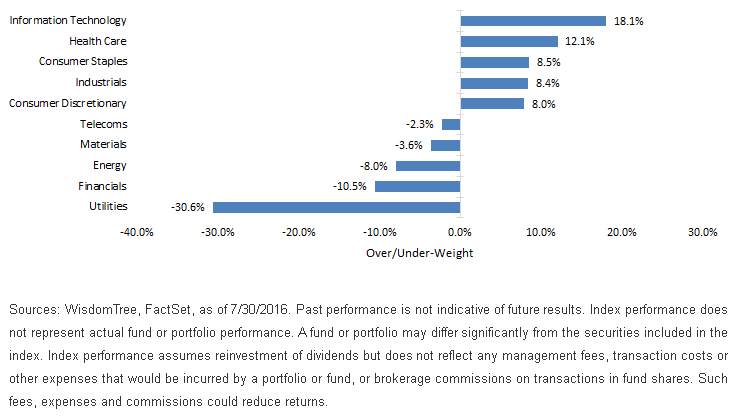Risks of Dividend Strategies Overweight in Utilities


 WT Sector Over/Under-weight to Dow Jones
WT Sector Over/Under-weight to Dow Jones
 Differentiated Exposures
In addition to the unique fundamental characteristics of the WisdomTree U.S. Quality Dividend Growth Index (WTDGI), we find some noteworthy over- and under-weights in the portfolio. The biggest over-weight is in Information Technology. We find that this reflects WisdomTree’s forward-looking approach to dividend growth. Many indexes that rely on backward-looking dividend growth screens miss out on the performance of the Information Technology sector, where we often find relatively younger companies. Contrast this with WTDGI’s under-weights to Utilities and Financials, typically sectors with higher leverage.
While there are many strategies attempting to capture dividend growth in the market today, they often utilize backward-looking screening criteria. At WisdomTree, we believe that WTDGI’s forward-looking methodology offers a differentiated approach. We believe WTDGI offers investors a unique way to access quality companies by screening for fundamental characteristics such as return on equity and return on assets. Pair this with a screen for long-term growth expectations, and we think WTDGI becomes a powerful tool for investors looking for quality companies as well as dividend growth.
1Sources: WisdomTree, Bloomberg as of 8/18/16.
2Sources: WisdomTree, Bloomberg as of 7/30/2016.
Differentiated Exposures
In addition to the unique fundamental characteristics of the WisdomTree U.S. Quality Dividend Growth Index (WTDGI), we find some noteworthy over- and under-weights in the portfolio. The biggest over-weight is in Information Technology. We find that this reflects WisdomTree’s forward-looking approach to dividend growth. Many indexes that rely on backward-looking dividend growth screens miss out on the performance of the Information Technology sector, where we often find relatively younger companies. Contrast this with WTDGI’s under-weights to Utilities and Financials, typically sectors with higher leverage.
While there are many strategies attempting to capture dividend growth in the market today, they often utilize backward-looking screening criteria. At WisdomTree, we believe that WTDGI’s forward-looking methodology offers a differentiated approach. We believe WTDGI offers investors a unique way to access quality companies by screening for fundamental characteristics such as return on equity and return on assets. Pair this with a screen for long-term growth expectations, and we think WTDGI becomes a powerful tool for investors looking for quality companies as well as dividend growth.
1Sources: WisdomTree, Bloomberg as of 8/18/16.
2Sources: WisdomTree, Bloomberg as of 7/30/2016.
Important Risks Related to this Article
Dividends are not guaranteed, and a company currently paying dividends may cease paying dividends at any time.

Jeremy Schwartz has served as our Global Chief Investment Officer since November 2021 and leads WisdomTree’s investment strategy team in the construction of WisdomTree’s equity Indexes, quantitative active strategies and multi-asset Model Portfolios. Jeremy joined WisdomTree in May 2005 as a Senior Analyst, adding Deputy Director of Research to his responsibilities in February 2007. He served as Director of Research from October 2008 to October 2018 and as Global Head of Research from November 2018 to November 2021. Before joining WisdomTree, he was a head research assistant for Professor Jeremy Siegel and, in 2022, became his co-author on the sixth edition of the book Stocks for the Long Run. Jeremy is also co-author of the Financial Analysts Journal paper “What Happened to the Original Stocks in the S&P 500?” He received his B.S. in economics from The Wharton School of the University of Pennsylvania and hosts the Wharton Business Radio program Behind the Markets on SiriusXM 132. Jeremy is a member of the CFA Society of Philadelphia.

